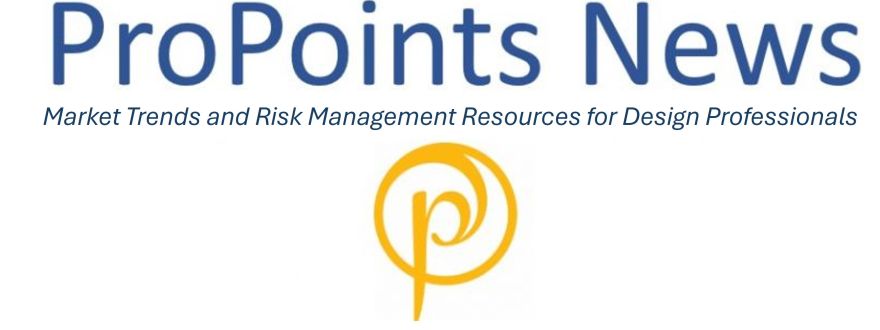
Proactive Strategies for a Shifting Design Landscape
The design professions are undergoing rapid change. As architecture, engineering, and surveying (AES) firms embrace new technologies, collaborative project delivery methods, and increasing sustainability mandates, they also encounter new and evolving risks. Firms that thrive will be those that not only anticipate these challenges but also actively manage them. Here are five of the most pressing emerging risks, and how forward-thinking firms are addressing them.
The Rising Risk of Performance-Based Sustainability Commitments
Sustainability has moved from a value-add to a core expectation, with clients now seeking measurable results in energy efficiency, carbon reduction, and resiliency. Yet, these performance goals are often shaped by evolving codes, vague client aspirations, or future conditions that the design professional cannot control.
When clients assume that LEED certification, net-zero performance, or green infrastructure guarantees are part of the deliverable, firms can find themselves liable for outcomes they never agreed to deliver. The problem is exacerbated when marketing materials or proposal language oversell performance or blur the line between aspiration and obligation.
To manage this risk, firms are refining their contracts to clearly define their scope and exclude guarantees of performance. They are also actively educating clients about what sustainability means in terms of design responsibility versus operational performance, especially as concerns about climate change and extreme weather events impacting client expectations.
Role Confusion in Collaborative and Alternative Project Delivery
Design-build, IPD (Integrated Project Delivery), and public-private partnerships are becoming standard alternatives to the traditional design-bid-build model. While these approaches promise improved coordination and faster delivery, they also complicate professional roles.
In integrated teams, design professionals may appear to share control over construction execution or even cost decisions. This perception can expose firms to claims tied to construction defects, project delays, or cost overruns, even when those issues originate beyond the designer’s control.
Firms are combating this by drawing firmer boundaries in their scopes of services and contract language. They document responsibilities meticulously and clarify that they are not assuming control over means, methods, or construction schedules. Insurance coverage is also under scrutiny, as some policies may not fully respond to claims arising from blended roles in alternative delivery models. Staying insured (and protected) requires policy reviews aligned with your firm’s project structure.
Cybersecurity Threats and Data Vulnerabilities in a Digital Practice
As AES firms adopt BIM, drone imaging, cloud-based document sharing, and mobile field apps, they’re exposed to an unprecedented level of digital risk. Even small firms are now frequent targets of cyberattacks, particularly when working on sensitive infrastructure or public sector projects.
A ransomware attack can paralyze project delivery, breach client confidentiality, and open the firm to breach-of-contract claims or regulatory fines. And beyond external attacks, internal mismanagement of data, such as version control errors or accidental exposure of sensitive site information, can also create significant liability.
Recognizing that cyber risk is no longer just an IT issue, many firms are integrating data governance into their enterprise risk strategies. This includes stronger access controls, staff training, and dedicated cyber insurance policies. More importantly, they are beginning to define digital responsibilities contractually and set boundaries around what data they are accountable for, how it must be used, and what happens in the event of a breach.
Workforce Volatility and the Loss of Institutional Knowledge
With a generation of senior professionals reaching retirement and younger talent entering the workforce with evolving expectations, many firms are struggling to maintain consistency and quality across project teams. Staff turnover, remote work, and compressed project timelines often result in less mentorship, weaker QA/QC, and an increased risk of design errors.
The loss of institutional knowledge, from how certain codes are interpreted to how past projects were handled, can have real consequences, especially when unseasoned staff are asked to fill leadership roles or when junior teams are stretched thin across larger, more complex projects.
To mitigate these risks, firms are investing in formalized training programs, building structured peer review into project workflows, and capturing legacy knowledge through internal databases and standardized processes. Some are also reevaluating their onboarding and hiring practices to ensure that new talent doesn’t just fill roles, but are properly supported to succeed.
AI, Automation, and the Evolving Standard of Care
Artificial intelligence and automation tools are rapidly changing how projects are conceived, designed, and documented. From generative design algorithms and real-time clash detection to automated code review tools, these technologies offer real advantages. But they also introduce ambiguity, especially when firms rely on outputs that haven’t been properly reviewed or vetted through professional judgment.
The legal and regulatory frameworks governing design services have not yet caught up with the pace of technological advancement. When errors emerge in AI-assisted models or automation tools fail to account for context, design firms may still be held responsible, even if the decisions were generated by algorithms.
Forward-looking firms are adopting a cautious but progressive approach. They are using AI to enhance productivity but always maintaining human review and professional oversight. They’re documenting their workflows carefully, disclosing the use of automation tools to clients, and updating their internal standards to ensure the evolving “standard of care” doesn’t drift away from sound design practice.
Staying Ahead of the Curve
The risks facing AES firms are complex and interconnected. From digital transformation and delivery model innovation to workforce dynamics and environmental accountability, the profession is evolving faster than ever. The firms that succeed will be those who integrate risk management into every aspect of their practice: contractually, culturally, and operationally.
At Promark Partners, we help design professionals proactively identify and address emerging risks through specialized insurance products, strategic contract reviews, and ongoing education. If your firm is facing these challenges, or preparing for them, we're ready to support you with tailored solutions.
Let’s Talk:
eric@promarkinsurance.com | 716-633-8401 | www.promarkdesignrisk.com
Promark Partners Insurance Services: Your Partner in Professional Liability & Strategic Risk Management






